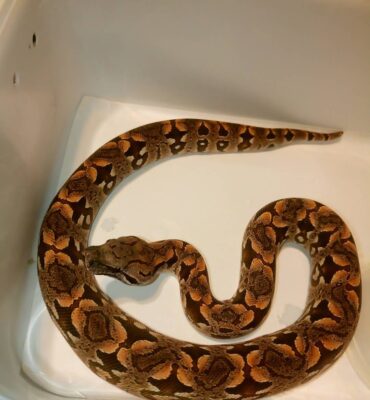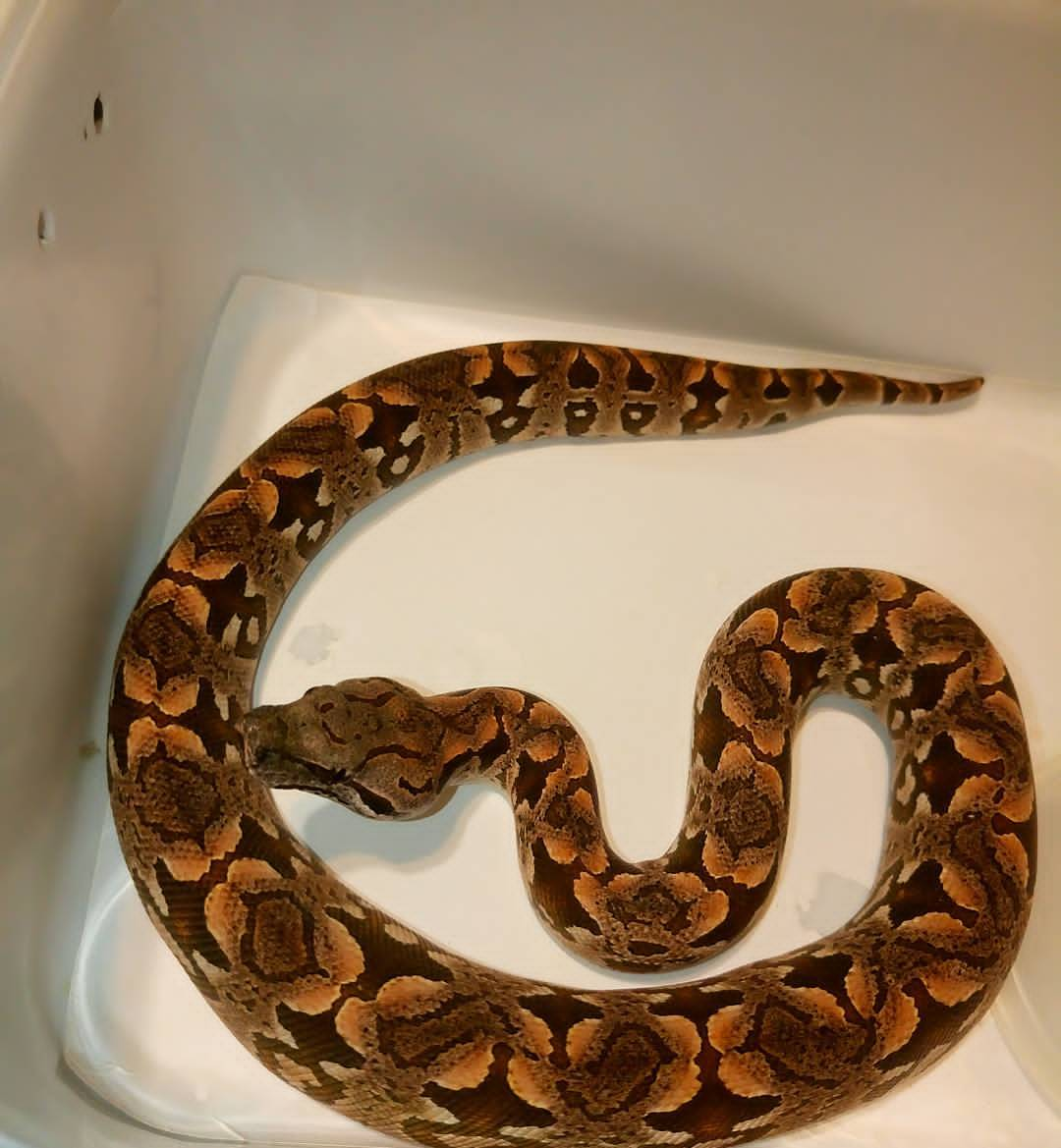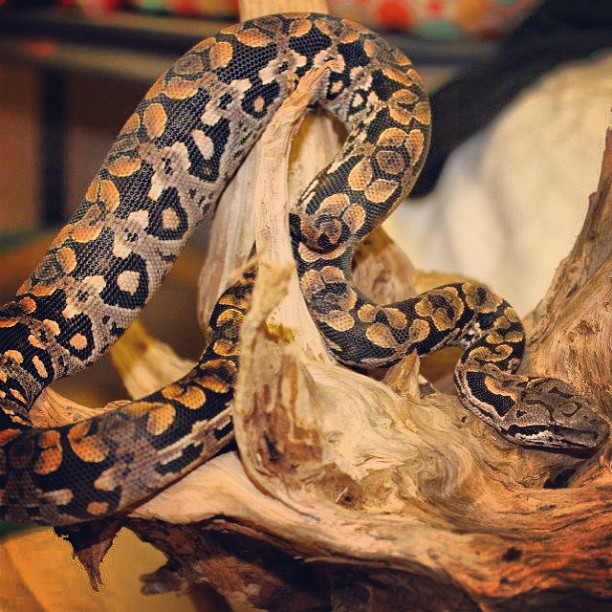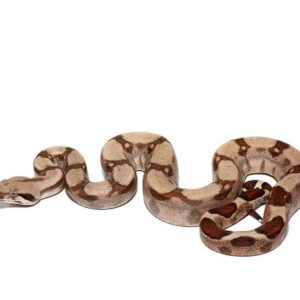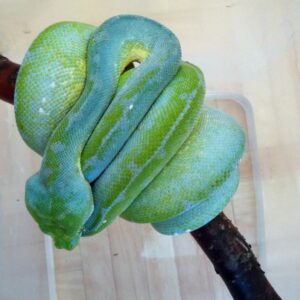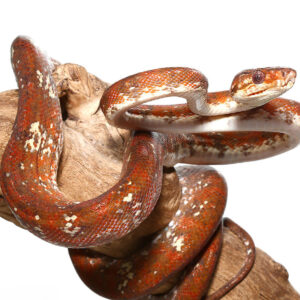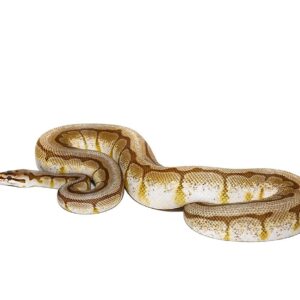Dumerils Boa For Sale
$320.00
Dumerils boa is a captivating snake species which is massive and loved by all. This gorgeous creature is considered to be an extremely beautiful snakes on the market. If you’re looking for a simple to take care of and affectionate pet snakes, then Dumerils boa would be a great choice. this category. If you are interested, then be sure to look into its characteristics and behavior.
The snake is from southwest Madagascar which is why they are well-adapted to extreme temperatures. This is a benefit when you reside in hot areas such as those in the Middle east.
Another benefit of having such a snake is the fact that it’s non-venomous, which means the snake can be kept out of the reach with children too.
This snake is the most user-friendly snake there. So if you are just beginning to consider keeping reptiles for pets begin with this snake, and later move on to the next.
Dumerils Boa life span
To fully mature, Dumerils boa can take anywhere from 3 – 5 years. it’s a slow-growing snake. The lifespan of the snake is around 20 years or more, depending on how well they’re taken by their owners. If they’re provided with the essentials and extra care and pampering, they will last for longer than 20 years.
Description
Dumerils Boas, scientifically known as Acrantophis dumerili, are fascinating reptiles native to the isolated island of Madagascar. These snakes belong to the Boidae family, which comprises some of the largest and most intriguing snake species in the world. The allure of Dumeril’s Boas lies in their distinctive characteristics and relatively docile temperament, making them a popular choice among reptile enthusiasts.
Physically, Dumerils Boas are medium-sized snakes, generally reaching lengths of six to eight feet when fully grown. Their robust, muscular bodies are adorned with a beautiful pattern of brown, tan, and black markings, which provide excellent camouflage in their natural habitat. The intricate patterns on their scales mimic the forest floor’s leaf litter, allowing these boas to blend seamlessly into their environment. This natural camouflage is essential for both predation and protection against potential threats.
Native to the dry forests and scrublands of Madagascar, Dumerils Boas have adapted to a variety of environmental conditions. Their habitat is characterized by a mix of deciduous trees, shrubs, and rocky outcrops, providing ample hiding spots and hunting grounds. These snakes are primarily nocturnal, emerging at night to hunt for small mammals, birds, and occasionally other reptiles. Their ambush hunting strategy relies heavily on their ability to remain undetected until the perfect moment to strike.
One of the reasons Dumerils Boas are favored by reptile keepers is their generally calm demeanor. Unlike some other snake species, Dumerils Boas are known for their tolerance of handling and relatively low levels of aggression. This makes them suitable for both novice and experienced snake handlers. Additionally, their manageable size and straightforward husbandry requirements further enhance their appeal as pet reptiles.
In summary, the unique attributes of Dumerils Boas, from their striking appearance to their gentle nature, make them a captivating subject for both scientific study and pet ownership. Their presence in the reptile-keeping community continues to grow as more people discover the charm and intrigue of these remarkable snakes.
Natural Habitat and Geographic Distribution
Dumeril’s Boas, scientifically known as Acrantophis dumerili, are native to the island of Madagascar. This unique geographic distribution places them in a variety of environments, predominantly consisting of forests and scrublands. These habitats provide the necessary cover and resources that are crucial for their survival and well-being. In the forests, Dumeril’s Boas find ample opportunities to camouflage amidst the leaf litter, fallen branches, and dense underbrush, which aids in both predation and protection from potential threats.
The scrublands of Madagascar, characterized by their sparse vegetation and open spaces, present a different set of challenges and advantages. Here, Dumerils Boas adapt by utilizing their cryptic coloration to blend with the rocky and sandy terrain. This adaptation not only helps them avoid predators but also allows them to ambush prey effectively. The ability of these snakes to thrive in such varying environments is a testament to their adaptability and resilience.
Behaviorally, Dumerils Boas are primarily nocturnal, which means they are most active during the night. This nocturnal lifestyle helps them avoid the heat of the day and reduces the risk of encountering diurnal predators. During the day, they typically seek refuge in burrows, under rocks, or within dense vegetation. This behavior is not only a survival strategy but also plays a role in their thermoregulation, as the cooler, shaded areas help them maintain optimal body temperatures.
Dumerils Boas exhibit a remarkable ability to adapt to different environmental conditions. Whether in the humid forests or the arid scrublands, these snakes demonstrate a high degree of ecological plasticity. This adaptability is crucial for their survival, especially considering the environmental changes and habitat fragmentation occurring in Madagascar. By understanding the natural habitat and geographic distribution of Dumeril’s Boas, we can better appreciate the intricate balance of their ecological niche and the importance of conserving their habitats.
Physical Characteristics and Identification
Dumerils Boas, scientifically known as Acrantophis dumerili, exhibit a range of distinct physical characteristics that make them easily identifiable. These boas typically range in size from 4 to 6 feet in length, with some individuals reaching up to 7 feet. Their robust bodies are characterized by a stout, muscular build, which contributes to their overall strength and agility.
The coloration of Dumerils Boas is particularly striking and serves as a natural camouflage in their native habitat of Madagascar. Their dorsal side displays a complex pattern of earthy browns, grays, and tans, often interspersed with irregular blotches and bands. These colors blend seamlessly into the forest floor, aiding in their stealth and predator evasion. The ventral side tends to be lighter, with a cream or off-white hue that transitions smoothly from the darker dorsal colors.
One of the distinctive features of Dumerils Boas is their head shape. They possess a broad, triangular head that is noticeably wider than their neck, giving them a characteristic appearance. Their eyes are relatively small, with vertical slit pupils that are typical of nocturnal and crepuscular hunters. The scales on their bodies are smooth and glossy, enhancing their striking appearance.
Sexual dimorphism is present in Dumerils Boas, though it is subtle. Females are generally larger and heavier than males, a trait common among many boa species. Additionally, males may exhibit slightly longer spurs near their cloaca, remnants of hind limbs that are more prominent in males than in females.
Within the species, there are minor variations in pattern and coloration, often influenced by their specific geographic location. However, these variations are not significant enough to constitute different subspecies. The combination of their unique coloration, robust size, and specific head structure makes Dumerils Boas a fascinating subject for herpetologists and reptile enthusiasts alike.
Behavior and Temperament
Dumerils Boas, scientifically known as Acrantophis dumerili, exhibit a range of intriguing behavioral traits and temperaments that make them unique among reptile enthusiasts. In the wild, these boas are predominantly nocturnal, thriving in the cooler temperatures of the night to hunt and explore. They are known to be ambush predators, relying on their excellent camouflage to remain hidden until prey ventures close enough for a swift strike. Their diet consists primarily of small mammals, birds, and occasionally reptiles, which they subdue using constriction.
In captivity, Dumerils Boas maintain their nocturnal tendencies but can adapt to a more diurnal schedule based on their environment and feeding routines. These boas are generally docile and tolerant of handling, which makes them a favorable choice for both novice and experienced reptile keepers. However, it is important to approach them calmly and confidently, as sudden movements can startle them. Regular, gentle handling helps in acclimating these boas to human interaction, minimizing stress and promoting a more relaxed temperament.
When it comes to interaction with other animals, Dumerils Boas are solitary by nature. In the wild, they prefer to stay hidden and avoid confrontation. In a captive setting, it is advisable to house them individually to prevent stress and potential aggression. These boas are not particularly territorial, but they do appreciate having their own space. Providing a habitat with ample hiding spots and a stable environment mimics their natural conditions, contributing to their overall well-being.
Feeding Dumerils Boas in captivity is relatively straightforward. They accept pre-killed or frozen-thawed prey, which should be appropriately sized to avoid overfeeding or digestive issues. It’s essential to monitor their feeding habits and ensure a balanced diet to maintain their health. Understanding and respecting the natural behaviors and needs of Dumeril’s Boas is crucial for their care, ensuring they thrive both physically and mentally in a captive environment.
Housing and Environment in Captivity
Properly housing Dumerils Boas in captivity is crucial to their health and well-being. The ideal enclosure for an adult Dumerils Boa should be spacious enough to allow for movement and enrichment; a minimum size of 4 feet by 2 feet by 2 feet is recommended. This space helps to replicate their natural habitat, providing enough room for the snake to stretch and explore.
Temperature regulation is a critical aspect of Dumerils Boa care. These boas thrive in a temperature gradient ranging from 75°F to 85°F, with a basking spot that reaches up to 90°F. Nighttime temperatures can safely drop to around 70°F, mimicking the natural temperature fluctuations found in their native environment. Employing a reliable thermostat to manage these conditions ensures a stable and healthy climate for the snake.
Maintaining proper humidity is equally important. Dumerils Boas require a humidity level between 50% and 60%, which can be achieved by regular misting and the use of a hygrometer to monitor the enclosure’s moisture levels. Providing a water dish large enough for the boa to soak in will also help regulate humidity and support hydration.
The choice of substrate can significantly impact the habitat’s overall effectiveness. Suitable options include aspen shavings, cypress mulch, or coconut husk, which help maintain humidity and allow for natural burrowing behaviors. Avoid substrates that are overly dusty or prone to mold, as these can cause respiratory issues.
Environmental enrichment is essential to mimic the natural habitat of Dumerils Boas. Incorporating branches, hides, and foliage within the enclosure offers mental stimulation and encourages natural behaviors such as climbing and hiding. Ensuring these elements are securely placed will prevent injury and enhance the overall living conditions for the snake.
By carefully attending to these housing and environmental needs, you can create a captive environment that promotes the health and longevity of Dumerils Boas, closely mirroring their natural settings.
Diet and Feeding Requirements
Dumerils Boas, scientifically known as Acrantophis dumerili, have specific dietary needs that must be met to ensure their health and longevity. These snakes are carnivorous, primarily feeding on small mammals and birds in their natural habitat. In captivity, their diet should closely mimic what they would consume in the wild to maintain optimal health. Common prey items include appropriately sized rodents such as mice and rats. For juvenile Dumerils Boas, smaller prey like pinky mice are suitable, gradually increasing in size as the snake grows.
Feeding frequency varies depending on the age and size of the Dumerils Boa. Juveniles should be fed every 5 to 7 days, while adult boas typically require feeding every 10 to 14 days. It’s important to monitor the snake’s body condition and adjust the feeding schedule accordingly. Overfeeding can lead to obesity, which can cause various health issues, whereas underfeeding can result in malnutrition.
When feeding Dumerils Boas, it’s advisable to use pre-killed or frozen-thawed prey to reduce the risk of injury to the snake. Live prey can sometimes fight back, potentially harming the snake. Additionally, feeding in a separate enclosure can help prevent substrate ingestion and encourage a more natural feeding response.
Ensuring proper nutrition involves more than just offering the right prey size and frequency. Prey items should be nutritionally balanced and free from pesticides or other harmful substances. Supplementing with vitamins and minerals is generally unnecessary if the diet consists of whole prey items. However, it’s essential to observe the snake for any signs of nutritional deficiencies, such as lethargy or abnormal shedding patterns.
Common feeding problems in Dumerils Boas may include refusal to eat, which can be caused by stress, illness, or suboptimal environmental conditions. Ensuring that the snake’s habitat mimics its natural environment in terms of temperature, humidity, and hiding spaces can help alleviate this issue. Consulting with a veterinarian experienced in reptile care is recommended if feeding problems persist.
Health and Common Medical Issues
Ensuring the health of Dumerils Boas is paramount for any responsible owner. Like all reptiles, Dumerils Boas can be susceptible to a range of medical issues, many of which are preventable with proper care. One of the most common health concerns in these snakes is respiratory infections. Signs of a respiratory infection include wheezing, nasal discharge, and lethargy. If any of these symptoms are observed, it is crucial to consult a veterinarian experienced in reptile care promptly.
Additionally, Dumerils Boas may face problems related to their skin and scales, such as shedding issues or skin infections. Incomplete sheds can lead to retained eye caps and other complications, often resulting from inadequate humidity levels in their enclosure. To prevent these issues, maintaining the correct humidity and providing a shedding box with moist substrate is recommended.
Another prevalent issue is parasitic infestations, both internal and external. Regular fecal examinations by a veterinarian can help detect internal parasites early. External parasites, such as mites, can be identified by frequent soaking behavior and visible specks on the snake’s skin. Quarantining new snakes and keeping the enclosure clean are critical preventive measures.
Maintaining optimal health for Dumerils Boas also involves routine health checks and an appropriate diet. Regularly weighing your snake and monitoring its feeding habits can provide early indicators of potential health problems. Ensuring a balanced diet that mimics their natural prey will contribute significantly to their overall well-being.
Preventative care plays a crucial role in the health of Dumerils Boas. Establishing a relationship with a veterinarian knowledgeable in reptile medicine, conducting regular health assessments, and adhering to proper husbandry practices can mitigate many health issues. By being proactive and attentive, owners can ensure their Dumeril’s Boas lead healthy, thriving lives.
Breeding and Reproduction
The breeding and reproductive aspects of Dumerils Boas (Acrantophis dumerili) present a captivating glimpse into the life cycle of these remarkable reptiles. Mating typically occurs in the cooler months, often from late autumn to early winter, when environmental conditions naturally simulate their native habitat. During this period, males exhibit heightened activity and courtship behaviors, such as tongue-flicking and body nudging, to entice a receptive female.
Once mating has taken place, the female undergoes a gestation period that can last between six to eight months. Unlike many reptiles, Dumeril’s Boas are viviparous, meaning they give birth to live young rather than laying eggs. This reproductive strategy provides neonates with a greater chance of survival as they are born fully formed and ready to fend for themselves. A typical litter size ranges from 12 to 20 offspring, though larger litters are not uncommon.
During gestation, it is crucial to provide gravid females with optimal care to ensure the health of both the mother and her developing young. An appropriately sized enclosure with ample hiding spots, consistent temperature gradients, and adequate humidity levels is essential. The female should be monitored closely for signs of stress or health issues, and her diet should be adjusted to meet the increased nutritional demands of pregnancy.
Upon the birth of the neonates, it is important to establish a separate, safe environment for the young snakes. Each neonate should be housed individually to prevent any inadvertent injuries or stress. Neonates generally exhibit a strong feeding response and can be offered appropriately sized prey items, such as pinkie mice, within their first week of life. Regular feeding and monitoring will support healthy growth and development.
Breeding Dumeril’s Boas in captivity can be a rewarding endeavor, provided that the specific needs of both the gravid females and neonates are met with diligence and care. By understanding and mimicking the natural breeding conditions, enthusiasts can contribute to the conservation and appreciation of these fascinating reptiles.
